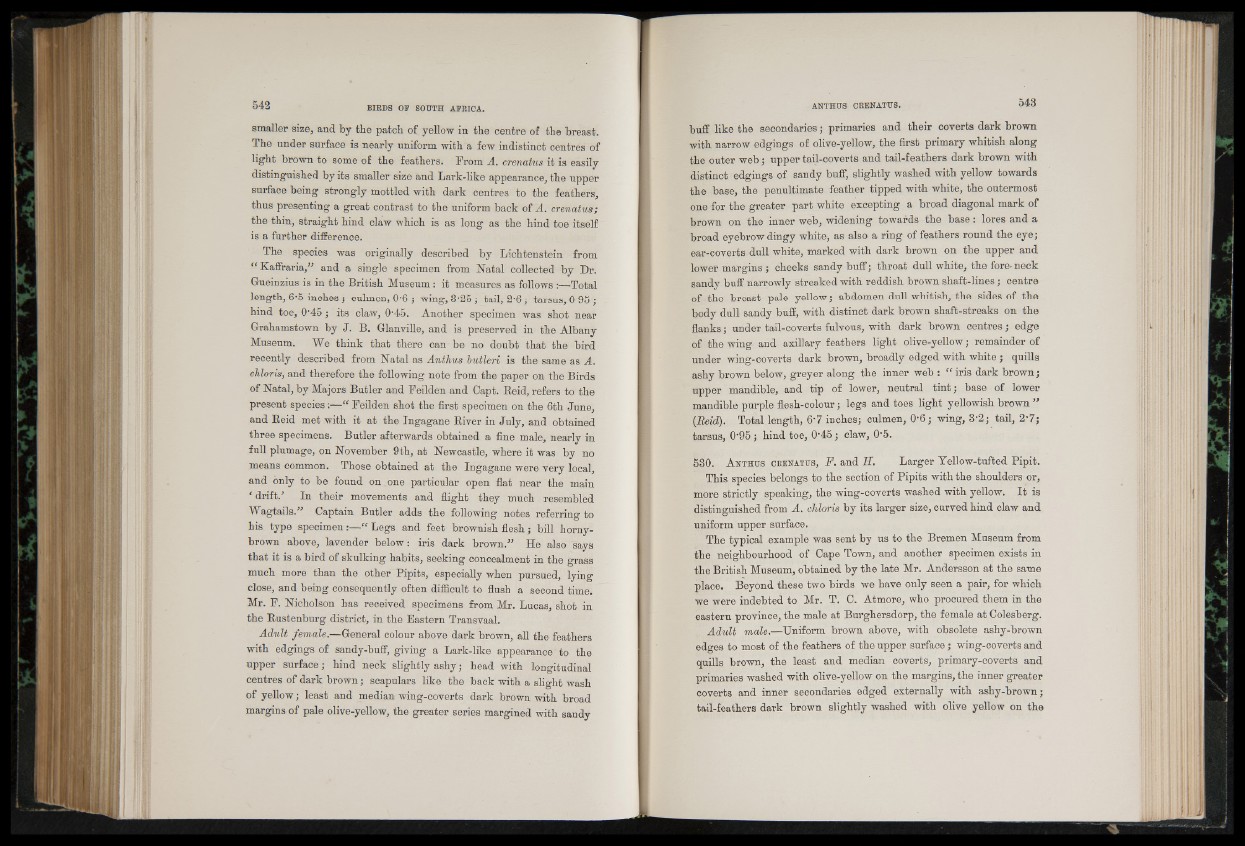
smaller size, and by the patch of yellow in the centre of the breast.
The under surface is nearly uniform with a few indistinct centres of
light brown to some of the feathers. From A. crenatus it is easily
distinguished by its smaller size and Lark-like appearance, the upper
surface being strongly mottled with dark centres to the feathers,
thus presenting a great contrast to the uniform back of A. crenatus;
the thin, straight hind claw which is as long as the hind toe itself
is a further difference.
The species was originally described by Lichtenstein from
“ Kaffraria,” and a single specimen from Natal collected by Dr.
Gueinzius is in the British Museum : it measures as follows :—Total
length, 6-5 inches ; culmen, 0'6 ; wing, 3'25; tail, 2-6; tarsus, 095 ;
hind toe, O'45; its claw, 0'45. Another specimen was shot near
Grahamstown by J. B. Glanville, and is preserved in the Albany
Museum. We think that there can be no doubt that the bird
recently described from Natal as Anthus butleri is the same as A.
chloris, and therefore the following note from the paper on the Birds
of Natal, by Majors Butler and Feilden and Capt. Reid, refers to the
present species:—“ Feilden shot the first specimen on the 6th June,
and Reid met with it at the Ingagane River in July, and obtained
three specimens. Butler afterwards obtained a fine male, nearly in
full plumage, on November 9th, at Newcastle, where it was by no
means common. Those obtained at the Ingagane were very local,
and only to be found on one particular open flat near the main
‘ drift/ In their movements and flight they much resembled
Wagtails.” Captain Butler adds the following notes referring to
his type specimen :—“ Legs and feet brownish flesh; bill horny-
brown above, lavender below: iris dark brown.” He also says
that it is a bird of skulking habits, seeking concealment in the grass
much more than the other Pipits, especially when pursued, lying
close, and being consequently often difficult to flush a second time.
Mr. F. Nicholson has received specimens from Mr. Lucas, shot in
the Rustenburg district, in the Eastern Transvaal.
Adult female.—General colour above dark brown, all the feathers
with edgings of sandy-buff, giving a Lark-like appearance to the
upper surface j hind neck slightly ashy ; head with longitudinal
centres of dark brown; scapulars like the back with a slight wash
of yellow; least and median wing-coverts dark brown with broad
margins of pale olive-yellow, the greater series margined with sandy
buff like the secondaries; primaries and their coverts dark brown
with narrow edgings of olive-yellow, the first primary whitish along
the outer web; upper tail-coverts and tail-feathers dark brown with
distinct edgings of sandy buff, slightly washed with yellow towards
the base, the penultimate feather tipped with white, the outermost
one for the greater part white excepting a broad diagonal mark of
brown on the inner web, widening towards the base: lores and a
broad eyebrow dingy white, as also a ring of feathers round the eye;
ear-coverts dull white, marked with dark brown on the upper and
lower margins ; cheeks sandy buff; throat dull white, the fore-neck
sandy buff narrowly streaked with reddish brown shaft-lines; centre
of the breast pale yellow; abdomen dull whitish, the sides of the
body dull sandy buff, with distinct dark brown shaft-streaks on the
flanks; under tail-coverts fulvous, with dark brown centres; edge
of the wing and axillary feathers light olive-yellow; remainder of
under wing-coverts dark brown, broadly edged with white ; quills
ashy brown below, greyer along the inner web : <e iris dark brown;
upper mandible, and tip of lower, neutral tin t; base of lower
mandible purple flesh-colour; legs and toes light yellowish brown ”
{Reid). Total length, 6'7 inches; culmen, 0'6; wing, 3'2; tail, 2'7;
tarsus, 0-95; hind toe, 0'45; claw, 0'5.
530. A n th u s crenatus, F. and II. Larger Yellow-tufted Pipit.
This species belongs to the section of Pipits with the shoulders or,
more strictly speaking, the wing-coverts washed with yellow. It is
distinguished from A. chloris by its larger size, curved hind claw and
uniform upper surface.
The typical example was sent by us to the Bremen Museum from
the neighbourhood of Cape Town, and another specimen exists in
the British Museum, obtained by the late Mr. Andersson at the same
place. Beyond these two birds we have only seen a pair, for which
we were indebted to Mr. T. 0. Atmore, who procured them in the
eastern province, the male at Burghersdorp, the female at Colesberg.
Adult male.—Uniform brown above, with obsolete ashy-brown
edges to most of the feathers of the upper surface; wing-coverts and
quills brown, the least and median coverts, primary-coverts and
primaries washed with olive-yellow on the margins, the inner greater
coverts and inner secondaries edged externally with ashy-brown;
tail-feathers dark brown slightly washed with olive yellow on the